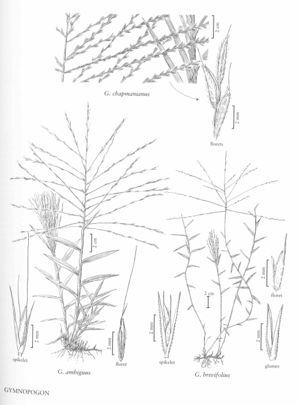Difference between revisions of "Gymnopogon chapmanianus"
imported>Volume Importer |
imported>Volume Importer |
||
| Line 47: | Line 47: | ||
|publication year= | |publication year= | ||
|special status=Endemic | |special status=Endemic | ||
| − | |source xml=https:// | + | |source xml=https://bitbucket.org/aafc-mbb/fna-data-curation/src/2e0870ddd59836b60bcf96646a41e87ea5a5943a/coarse_grained_fna_xml/V25/V25_835.xml |
|subfamily=Poaceae subfam. Chloridoideae | |subfamily=Poaceae subfam. Chloridoideae | ||
|tribe=Poaceae tribe Cynodonteae | |tribe=Poaceae tribe Cynodonteae | ||
Revision as of 21:05, 5 November 2020
Plants usually perennial; cespitose from a knotty base. Culms 20-70 cm, erect to sprawling, simple or sparingly branched from the lower nodes. Sheaths glabrous; ligules 0.1-0.3 mm; blades 1.3-8.5 cm long, 2-8 mm wide, glabrous. Panicles 8-23.5 cm; branches 2-15 cm, ascending, widely spreading, or reflexed, spikelet-bearing from the base or naked for less than 1/3 of their length. Spikelets with (1)2-3(4) florets. Glumes to 6 mm, sometimes widely divergent; lemmas of bisexual florets 1.5-2.3 mm, unawned or awned, awns 0.7-2.2 mm; terminal sterile florets minute, rudimentary, awned, awns not exserted from the spikelets; anthers 3, 0.5-0.8 mm. Caryopses 1.2-1.5 mm long, 0.3-0.4 mm wide. 2n = unknown.
Discussion
Gymnopogon chapmanianus grows in sandy pine barrens and sites inhabited by dwarf palmetto, Serenoa repens. As interpreted here, G. chapmanianus includes G. floridanus Swallen. Smith (1971) treated the two as distinct species, but he acknowledged that they over¬lapped morphologically, ecologically, and geographically. Subsequent fieldwork has not supported the recognition of two entities. Smith's most intriguing observation was that only plants fitting the G. floridanus end of the morphological range produced mature caryopses. The reproductive biology of G. chapmanianus merits examination.
Selected References
None.
